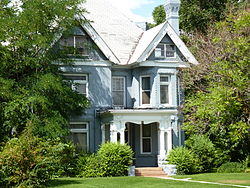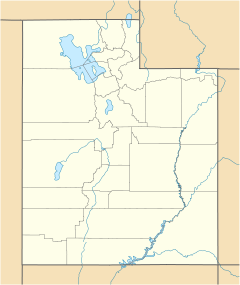- Dr. Samuel H. Allen House and Carriage House
-
Dr. Samuel H. Allen House and Carriage House
 Samuel H. Allen Home
Samuel H. Allen HomeLocation: 135 E. 200 North
Provo, UtahCoordinates: 40°14′12″N 111°39′19″W / 40.23667°N 111.65528°WCoordinates: 40°14′12″N 111°39′19″W / 40.23667°N 111.65528°W Area: less than one acre Built: 1897 Architectural style: Late 19th And 20th Century Revivals, Queen Anne NRHP Reference#: 79002515[1] Added to NRHP: May 18, 1979 The Samuel H. Allen Home is a historic house located at 135 E. 200 North in Provo, Utah. It is listed on the National Register of Historic Places.
Contents
Description
This home is a good example of the architectural transition from the Queen Anne style to turn-of-the-century revival styles, which emphasized symmetry and classical detailing. "A two-and-a-half story brick Victorian, the Allen home is well-maintained and largely original on the front facade; the most visible changes are the metal sash windows in the third floor gables. The rear facade has been greatly altered. A large shed dormer the full width of the home eliminates the sweep and dominance of the roof. The dormer is faced with metal siding, the windows are metal sash and too small to carry the scale of the dormer. The basic form of the house is square with a pyramidal roof. Two bays, one flat and one half-octagonal, project about three feet forward on each side of the entrance porch. The two bays, with prominent gable roofs, disguise the simple mass of the basic structure. The left bay has a large, fixed light on the first floor and a matching opening with a pair of double-hung, one-over-one windows on the second floor. Both openings have stained glass thransoms above. All the windows have cut stone lintels and sills; the lintels on the first floor and the sills on the second floor are tied together with continuous brick belt courses. The center window openings in the half-octagonal bay are also filled in with stained glass transoms. The gables of both bays are outlined with simple bargeboards with rectilinear detailing; both gable windows are topped with a shingle eyebrow hood. The entrance porch projects about six feet beyond the two bays. The foundation of rusticated stone rises above the porch floor about three feet, with the porch columns resting on the stone. The porch is classically detailed, with dentilling and swags. The house is well-maintained and largely original on the front facade; the most visible changes are the metal sash windows in the third floor gables. The rear facade has been greatly altered. A large shed dormer in the full width of the house eliminates the sweep and dominance of the roof. The dormer is faced with metal siding, the windows are metal sash and too small for the scale of the dormer. A large brick carriage house at the rear is in fair condition with few alterations. Built of matching brick, it has two carriage entrances on the main facade with a clerestory roof above running the full length of the carriage house. The interior of the house has remained essentially intact, but for the finishing off of the attic space. In October of 1963 the Paxmans won a Better Homes and Gardens Grand Prize for their tasteful and practical renovation of the house. It graced the magazine cover for that month (National Register of Historic Places Inventory—Nomination Form)."
Except for wide, curved horizontal and vertical brackets, the porch is classically detailed. This is one of the tallest and largest historic houses in Provo, and its two-story carriage may be the single largest building of its type. The heavy landscaping somewhat obscures the building's massiveness. The single-family dwelling has four major projections, each gabled, extending from the rusticated stone lintels, ornamental porch and bargeboards, polychrome color scheme, and combination of square and slanted bay wings. In good condition and relatively unaltered, the house is architecturally significant, as is the monitor-form carriage house, the lower level bays of which has been filled with windows.
The Victorian Mansions of Provo
Constructed between 1893 and 1908 in Provo, Utah, these Victorian mansions reflect the wealth and personality of Utah's most successful entrepreneurs of the time. These mansions include the Charles E. Loose House, the William H. Ray House, the Knight-Allen House, the John R. Twelves House, the Jesse Knight House, the Knight-Mangum House, and the Thomas N. Taylor House. "Built during the turn of the century from 1893 to 1908, the domestic residences of Provo's prominent entrepreneurs reflect the wealth, power, and aesthetic taste of their owners and of America's Gilded Age. Larger in size, more complicated in their massing, and ornate in their detailing than the typical residences of Provo, these houses are the Victorian mansions of the city. All derive from the high style popular at the end of the nineteenth century: Eastlake, Italianate, Shingle, Craftsman, Moorish, and the Classical, Romanesque and Colonial Revivals. Although the high styles are of a purer form in these houses than is usually found in Provo, an eclectic attitude still dominates with several styles often being combined into one residence. Characteristic of all these buildings is a compactness and a low earth-hugging quality, which is typical of Provo's architecture but antithetical to the optimistic verticality of Salt Lake's Victorian buildings. As is true of the majority of Provo's residences, these houses are made primarily of brick, including elaborate ornamental coursing and trim. The Victorian fascination with a variety of rich materials is visible only in the use of masonry in the foundations, lintels and arches of these buildings and in the extensive use of leaded and stained glass in the windows. Some of the most ornate fenestration to be found in Provo is contained in these buildings. In comparison to the buildings in Salt Lake City, these Victorian mansions are modest in size, style, and materials, but are more reflective of the high styles than those generally found in Utah's small towns such as Manti or Spring City (National Register of Historic Places Inventory—Nomination Form)."
History
Dr. Samuel H. Allen relocated to Provo in 1892, and built his beautiful home using local workers and materials. For a few years, he also ran his medical office out of his home, but the office was moved to the Knight block after it was built. In 1903 Samuel R. Thurman bought the home from Allen. S. R. Thurman had previously been mayor to the city of Lehi prior to moving to Provo in 1882. "In 1882 he was elected the youngest member of the Utah House of Representatives. He was returned in several succeeding election years. Thurman was a member of the Utah Constitutional Convention of 1882; of the 1888 convention, which framed the first anti-polygamy constitution and of the 1895 convention, which framed what became the Utah State Constitution. Thurman was chairman of the committee which drafted the first platform of the Provo People's Party in 1882. The People's Party was the Mormon party, which had been organized in Salt Lake in reaction to the organization in 1870 of the anti-Mormon Liberal Party. The first Utah County Convention of the Liberal Party was September, 1880. George Sutherland, of whose firm Thurman was then a member, acted as secretary of the convention. Sutherland was later to become a United States senator and later a justice of the Supreme Court. As national parties began to replace these local parties, Thurman, like many Mormons of that era, became a Democrat. Thurman eventually became a judge on the Supreme Court of Utah. Thurman did not live long in the home before he sold it to John W. Taylor and moved to 600 E. Center St. John W. Taylor housed his third wife, Nellie Eva Todd there; his second wife, Nettie, was housed nearby at 287 E 200 N. John W. Taylor was the son of John Taylor, third president of the Mormon Church. After moving to Provo, Taylor bought four farms in the area which were run as a family business. Another family business was a millinery business which Nellie supervised and operated, first from the home but soon from a shop at 159 N. Academy Ave. It was a business, later called Avenue Millinery, which continued successful operation for many years. in 1915, John Taylor was excommunicated from the Mormon Church. By then, financial reverses forced him to sell this and the other house in Provo (National register of Historic Places Inventory—Nomination Form)."
Taylor sold this house to Dr. David Westwood, who had become vice-president of the Provo General Hospital, Provo's first hospital. Westwood used part of the home as his office. Later, his son John T., a dentist, and his family also lived in the home and shared an office (65 E 2nd N) with him. During the 1940s, the house was left vacant when the Westwood's moved away. In 1952, Monroe and Shirley Paxman bought the home and have continued to live there since. The Samuel H. Allen House was designated a historic Provo City landmark on April 28, 1995.
References
- ^ "National Register Information System". National Register of Historic Places. National Park Service. 2010-07-09. http://nrhp.focus.nps.gov/natreg/docs/All_Data.html.
- MacKay, Kathryn L. "National Register of Historic Places Inventory—Nomination Form." Utah State Historical Society. May 1978.
- Taylor, Samuel Woolley, Family Kingdom, SLC: Western Epics, Inc. 1974.
- Polks City Directory of Provo, 1891.
- Sanborn Maps 1890.
- Shirley Paxman, Interview, November 7, 1977
- Journal History, LDS Church, LDS Church Archives
External links
U.S. National Register of Historic Places Topics Lists by states Alabama • Alaska • Arizona • Arkansas • California • Colorado • Connecticut • Delaware • Florida • Georgia • Hawaii • Idaho • Illinois • Indiana • Iowa • Kansas • Kentucky • Louisiana • Maine • Maryland • Massachusetts • Michigan • Minnesota • Mississippi • Missouri • Montana • Nebraska • Nevada • New Hampshire • New Jersey • New Mexico • New York • North Carolina • North Dakota • Ohio • Oklahoma • Oregon • Pennsylvania • Rhode Island • South Carolina • South Dakota • Tennessee • Texas • Utah • Vermont • Virginia • Washington • West Virginia • Wisconsin • WyomingLists by territories Lists by associated states Other Categories:- Houses completed in 1897
- Houses in Utah County, Utah
- Houses on the National Register of Historic Places in Utah
- National Register of Historic Places in Utah
- Queen Anne architecture in the United States
- Buildings and structures in Provo, Utah
Wikimedia Foundation. 2010.

